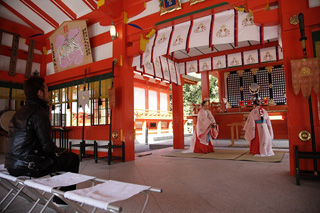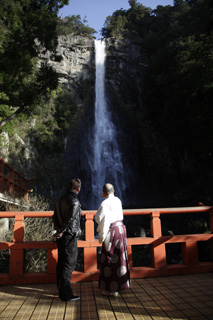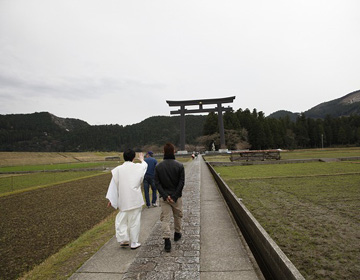 |
Belief derived from the depths of natureFrom ancient times, Kumano was believed to be a sacred place where Gods went into hiding. It is a spiritual place where Shintoism and Buddhism coexist, after the two religions merged and nurtured various forms of worship. It is said that Kumano was originally written as ”Kuma No Tokoro” (Place of Kumano). Geographically, Kumano is located near Kyoto and Nara, however, there are more than 3600 mountain peaks in between, leading to the belief that it represented a spiritual ”land of the dead”. |
”Purified land on earth” registered as a World HeritageKumano has three great shrines known as ”Kumano Sanzan”. After the Heian period when Jodo Shinshu spread, the Gods at ”Kumano Sanzan” were known as follows. The main deity of the Hongu Taisha shrine, ”Ketsumiko no Ookami”, is considered to be Amitabha, and the shrine is considered to be ”the western paradise”. Kumano-Hayatama-Taisha shrine’s ”Kumano hayatamao no kami” is considered to be Bhaisajyaguru (buddha able to cure all ills), and the shrine is ”the eastern pure land”. At Nachi shrine which enshrines Otaki Fall of Nachi resides ”Kumano fusumi no kami” which is Buddha of Thousand Arms, and the shrine is considered to be ”the southern Mount Potalaka Pure Land”. This is how Kumano which was regarded as ”the land of the dead” became to be regarded as the pure land on earth. In July 2004, the so called Kumano old road was registered as a World Heritage Site as ”spiritual place and pilgrimage road of the Kii mountains”. In Kumano, one would be cleansed of impurities, to be reborn. |
 |
ACCESS
- Kumano-Hongu-Taisha, Kumano-Nachi-Taisha, Kumano-Hayatama-Taisha
- Wakayama prefecture
 Discovering Japan [Nihon] through authentic craftsmanship [Honmono]
Discovering Japan [Nihon] through authentic craftsmanship [Honmono]